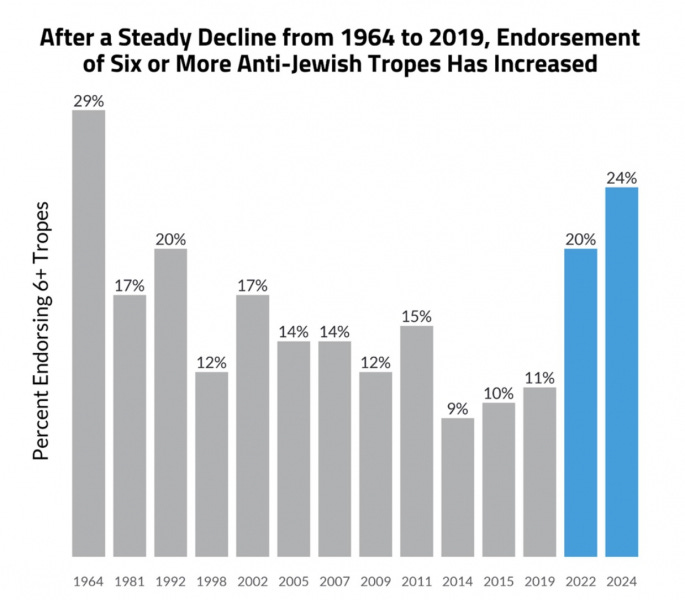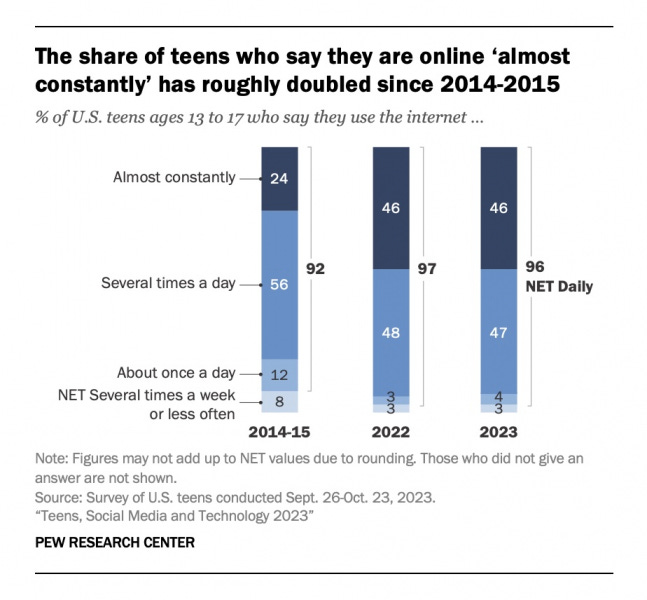Why Antisemitism Is Spreading Faster Than Truth
Various datasets explain why so many young people despise Jews — and what it says about all of us.
Please consider supporting our mission to help everyone better understand and become smarter about the Jewish world. A gift of any amount helps keep our platform free of advertising and accessible to all.
This is a guest essay written by David Swindle, a Zionist activist and a journalist primarily writing about antisemitism.
You can also listen to the podcast version of this essay on Apple Podcasts, YouTube Music, YouTube, and Spotify.
The Anti-Defamation League recently asked people in 103 countries whether they agreed with 11 antisemitic statements including: “Jews are responsible for most of the world’s wars,” “Jews have a lot of irritating faults,” “Jews have too much control over the media,” and “Jews’ loyalty is only to Israel.”1
The ADL Global 100 survey for 2024 classified almost half of respondents as “possessing antisemitic attitudes” because they agreed with at least six of the 11 statements.
Of course, an average that high means that in some places, the percentage stands considerably higher: 92 percent in Saudi Arabia, 62 percent in Russia, 58 percent in China, and the highest level, at 97 percent in the West Bank and Gaza.
Another ADL survey polled 4,143 Americans in January 2024, finding that 24 percent embraced at least six antisemitic sentiments.2
Not surprisingly, some of these findings are connected to Hamas’ October 7, 2023, attack on Israel and Israel’s ongoing military response. A January report from the World Zionist Organization and the Jewish Agency for Israel found a 340 percent increase in total antisemitic incidents at a global level in 2024 compared to 2022.3 This included a 562 percent rise in Canada, 450 percent in the United Kingdom, 350 percent in France, and 288 percent in the United States.
Antisemitic attitudes have increased in recent years, as shown here in a survey conducted by the ADL.
On April 22nd, the ADL released the results of its 2024 audit of antisemitic incidents. The group found 9,354 antisemitic incidents across the United States, equating to a 5 percent increase from 2023, a 344 percent increase over the past five years, and a jump of 893 percent since 2014.4
This increase in both antisemitic beliefs and hate crimes impacts day-to-day Jewish life. On February 12th, the American Jewish Committee released the results of a survey of a representative sample of 1,732 American Jews. The group found that 56 percent of respondents reported changing their behavior out of fear of encountering antisemitism, 77 percent felt less safe as a Jewish person in America, and 33 percent said they had experienced anti-Jewish hate at least once in the last year.5
It would be wrong, however, to ascribe the rise of antisemitism simply to the war in Gaza. Both the ADL’s global data and its figures for the U.S. show that this hatred has been growing markedly in the last decade. In 2014, 26 percent of respondents worldwide agreed with at least six of the 11 antisemitic statements; in 2024, it was 46 percent.
The rise was even sharper in the United States, where much of the increase occurred before the October 7th attacks. In 2019, the ADL determined that 11 percent of Americans possessed antisemitic views; in 2022, that number had almost doubled, reaching 20 percent.
One more set of statistics provides context for the current rise of antisemitism. The rate of antisemitism is not rising primarily because previously non-bigoted people in their 40s, 50s, 60s, and 70s have embraced hatred. The ADL’s Global 100 report found that, globally, 50 percent of those under 35 embrace antisemitism, compared to just 37 percent for those over 50.
Likewise, while 48 percent of overall respondents express a historically accurate understanding of the Holocaust, that number drops to 39 percent among those 18 to 34. Forty percent of those under 35 agreed with the statement “Jews are responsible for most of the world’s wars,” compared to 29 percent of those over 50.
Focusing on the United States, this data suggests that contemporary problems — especially the rise of social media which can act as an echo chamber for extremist views, the toll of isolation during COVID lockdowns on vulnerable young people, and fears about the future rooted in climate change and the increasing unaffordability of modern life — are powering this ancient scourge.
Decades of scholarship have shown that hatred directed against Jews is one of the most overt symptoms of a deeper disease: a moral confusion fueled by emotional trauma and its accompanying self-hatred. People turn to Jew-hatred because they actually hate themselves for creating the unsatisfying lives that they have.
Instead of accepting responsibility for their own realities and striving for self-improvement, they choose to obsess over centuries-old conspiracies about how 15.7 million nefarious people have orchestrated an elaborate scheme to sabotage them. Happy people, content with their lives and confident in themselves, do not need to find some external group to blame for their struggles.
Reframed into this context of rising global antisemitism as primarily a phenomenon driven by younger people’s unhappy coming-of-age, the data seem to fit like jigsaw-puzzle pieces into other alarming statistics about young people. This has been most notably explored in recent years by social psychologist Jonathan Haidt, and culminating in his March 2024 book, “The Anxious Generation: How the Great Rewiring of Childhood Is Causing an Epidemic of Mental Illness.”
The numbers he and other social scientists have compiled raise alarm in another area: The rate of diagnoses for depression and anxiety among college students doubled from 2010 through 2018. During that same decade, visits to emergency rooms for self-harm increased by 188 percent for teen girls and 48 percent for boys, while the suicide rate rose 167 percent for girls and 91 percent for boys.
What’s to blame? How has the world changed over the last 15 years?
While one can identify myriad factors, Haidt and others have dug into these trends’ data to pinpoint exactly when this greater youth unhappiness began. Jean Twenge, a San Diego State University psychology professor and author of 2017’s “iGen: Why Today’s Super-Connected Kids Are Growing Up Less Rebellious, More Tolerant, Less Happy — and Completely Unprepared for Adulthood,” argues that the rise in depression rates really began in 2012, when smartphone ownership passed 50 percent in the U.S.
Could the massive boom in antisemitism over the last decade really be linked to smartphone addiction among the young? We can consider three factors to understand how technology exacerbated the problem.
First is the point raised by Haidt and Twenge: that overuse of smartphones and social media correlates with greater levels of anxiety and depression. These extremes of emotion require coping methods, and the data now show that many have chosen Jew-hate.
Second, teachers and professors have seen major changes in the quality of the work submitted by their young students. Smartphone addiction diminishes people’s attention spans, crippling their ability to engage in deep thought. It’s harder to read, tougher to write, and for some students, an outright ordeal to make it through an hour-long class without getting those smartphone dopamine hits.
The data are clear about this. The lower the level of education one achieves, the higher the likelihood of the individual embracing antisemitism. Those untrained to think critically are more susceptible to antisemitic propaganda.
Third and finally, we must factor in what young people do all day on their personal devices. Among U.S. teenagers, Pew Research Center reported in 2023 that for those 13 to 17, 58 percent used TikTok daily, with 9 percent using it once a day, 32 percent several times a day, and 17 percent “almost constantly.”
Globally, those 18 to 24 make up approximately 36.2 percent of TikTok’s user base, while those 25 to 34 comprise about 34 percent. A May 2024 analysis of more than 280,000 U.S. TikTok posts with hashtags referencing the war in Gaza found that 170,430 advocated for Palestinians, 8,843 supported Israel, and 101,706 qualified as neutral. Looking up the number of views these videos received, 236 million went to the Palestinian content, 14 million to Israel, and 492 million views for the neutral videos.
The rise of anti-Israeli and antisemitic messages on social media has occurred at the same time that historical memory is receding.
On January 23rd, the Conference on Jewish Material Claims Against Germany released its “Index on Holocaust Knowledge and Awareness.” They surveyed people in the United States, the United Kingdom, France, Austria, Germany, Poland, Hungary, and Romania.
In America, 48 percent of adults could not name a concentration camp. In Romania, 28 percent of adults think that two million or fewer Jews were killed in the Holocaust. These numbers were similar across other countries: 27 percent in Hungary, 24 percent in Poland, 21 percent in France, 21 percent in the United States, 21 percent in Austria, 20 percent in the United Kingdom, and 18 percent in Germany.
In France, 20 percent of adults were not sure they had heard of the Holocaust; among those 18 to 29, it was 46 percent. This diminished Holocaust knowledge tracks across the young in other countries over previous years. A similar survey conducted in 2020 interviewed a demographically representative sample of 11,000 Americans aged 18 to 39. Researchers found that 63 percent of respondents did not know that the Nazis murdered 6 million Jews, and more than half of them believed that fewer than 2 million had died.
In the concluding chapter of the 2021 book, “People Love Dead Jews: Reports from a Haunted Present,” award-winning author Dara Horn explained the unsettling implications of the correlation between falling Holocaust knowledge and rising hate.
“Of all the tedious and self-serving explanations for why this scourge was apparently reemerging in American life (Guns! Trump! Trolls! Twitter!) the most convincing was actually the most boring, and also the most disturbing: the last few generations of American non-Jews had been chagrined by the enormity of the Holocaust — which had been perpetrated by America’s enemy and which was grotesque enough to make antisemitism socially unacceptable, even shameful,” wrote Horn wrote.
“Now that people who remembered the shock of those events were dying off, the public shame associated with expressing antisemitism was dying too. In other words, hating Jews was normal. And historically speaking, the decades in which my parents and I had grown up simply hadn’t been normal. Now, normal was coming back.”
Although current anxieties and knowledge gaps may be fueling the rise in antisemitism, perhaps the most remarkable aspect of this hatred is how it has remained largely unchanged through the millennia. The Jewish historian Josephus (37 to 100 AD) was one of the first scholars to grapple with the issue in “Against Apion,” history’s oldest written defense of the Jewish people. In it, he was not rebutting Christian tropes about the Jews but those created centuries before, including by the Egyptian historian Manetho (290 to 260 BC).
In Manetho’s telling, the ancient Hebrews are a group of lepers whom Egypt expelled. Moses was a heretical priest from Heliopolis named Osarseph who led the Jews as a people apart from all others and set laws contrary to Egypt’s before renaming himself “Moses.”
The Manetho narrative reveals the fundamentals of the anti-Jewish conspiracy theories that persist to this day, echoing the statements presented in the ADL’s Global 100 survey:
Jews are lying about who they are and what they want to accomplish. You cannot trust them.
Jews are not innocent victims; they’re the real oppressors.
Jews are physically revolting and spread disease.
Jews seek to subvert established religion and culture in order to advance their own interests.
Jews conspire amongst themselves to conquer the people they live amongst.
With anti-Jewish attitudes embedded in all four of the founding pillars of Western civilization — Egyptian, Greek, Roman, and Christian — the irrational hatred of Jews was ingrained into the Western consciousness. Exiles, pogroms, forced conversion, and confinement to ghettos shaped Jewish life until the Holocaust. Nevertheless, the image of Jews as a powerful, malevolent force persisted. One of the most influential modern articulations of this conspiracy theory was “The Protocols of the Elders of Zion,” which was published in a Russian newspaper in 1903.
“The Protocols” claims to be the minutes of a meeting of Jewish rabbis in which they describe their plans to dominate the world. The document was created and disseminated by Russia’s secret police, the Okhrana, with the original purpose of redirecting frustration with the czar toward the Jews.
“The Protocols” served antisemites then and today as hard proof that the mutating myths which began in Manetho’s days were true. Over the course of the 20th century it spread around the world, republished in Henry Ford’s “The Dearborn Independent,” promoted in Adolf Hitler’s Nazi Germany, spread in the Arab world by the KGB, and cited by name in the 1988 Hamas charter.
While it may seem subversive enough to take Horn’s step of recognizing the normalcy of antisemitism in Western civilization, taking the leap suggested by media theorist Douglas Rushkoff goes even further:
What if the antisemites do have genuine reasons to fear the Jewish people? What if Jewish ideas really are dangerous to some people?
Rushkoff, author of the 2003 book, “Nothing Sacred: The Truth About Judaism,” explained in an interview (ironically, in a clip spread by white supremacists, seeming to think he’d accidentally confessed some grand secret) how the principles of the Torah confronted lies.
“What makes Judaism so unsettling — so dangerous, even — to many people, across all nations, races, and ideologies, is that it challenges what is false,” said Rushkoff. “It refuses to accept boundaries like nation-states as absolute, and it doesn’t believe in tribal gods that exist solely to protect specific groups. These are artificial constructions. Judaism, at its heart, teaches us to see through them.”6
Rushkoff continued: “In a way, our critics aren’t entirely wrong: we are, indeed, a corrosive force — but in the sense that we erode illusions, tear down false idols, and dismantle ideas that lack truth. That can be deeply upsetting to people who are invested in those illusions.”
A version of this essay also appeared in RealClearInvestigations.
“46% of Adults Worldwide Hold Significant Antisemitic Beliefs, ADL Poll Finds.” Anti-Defamation League.
“Antisemitic Attitudes in America 2024.” Anti-Defamation League.
“Global Antisemitism Skyrocketed 340% From 2022 to 2024, Says New Report Presented to Israel’s President.” Algemeiner.
“Audit of Antisemitic Incidents 2024.” Anti-Defamation League.
“AJC Report: For the First Time, Majority of American Jews Changing Behavior Due to Fear of Antisemitism.” American Jewish Committee.
“Douglas Rushkoff: “the thing that makes judaism dangerous...’” YouTube.






As a black American member of the Christian community, I have to say that this is a problem that I’ve encountered among many of my peers. I am not surprised that antisemitism has become so common among us as a society, and personally I find it problematic, for the main reason being that Jewish people fought alongside our people for civil rights, and our history has been intertwined since the beginning of civilization. I stand with all my Jewish neighbors as a brother in Abrahamic origin and I can relate to my people being abused, victimized, and exploited as a people by persecutor propaganda. This is truly a prophetic mark of the times that we live in today and the New Testament speaks to a lot of what we’re seeing here.
Thank you, David! What I found most intriguing in your article was your input of how unhappy, smartphone-addicted /dopamine-addicted young people couldn‘t concentrate in school and therefore couldn’t get a higher education. What I find very helpful for regaining control of my life is what is called Emotional Freedom Techniques (EFT or simply “Tapping“). This self-help technique is easy and free of charge. Too much dopamine-inducing activity as a force to lessen our ability to concentrate is briefly mentioned in the Youtube video by Alex Ortner called “How to Get Yourself to Take Action Despite the Fear“ (Channel: The Tapping Solution Podcast). I recommend tapping because it has the ability to get you through various emotions. This video is just one example of what to do with tapping (EFT). I hope it‘s ok to have recommended it. I just wanted to contribute something concrete and helpful for those who would look into this. Thanks.